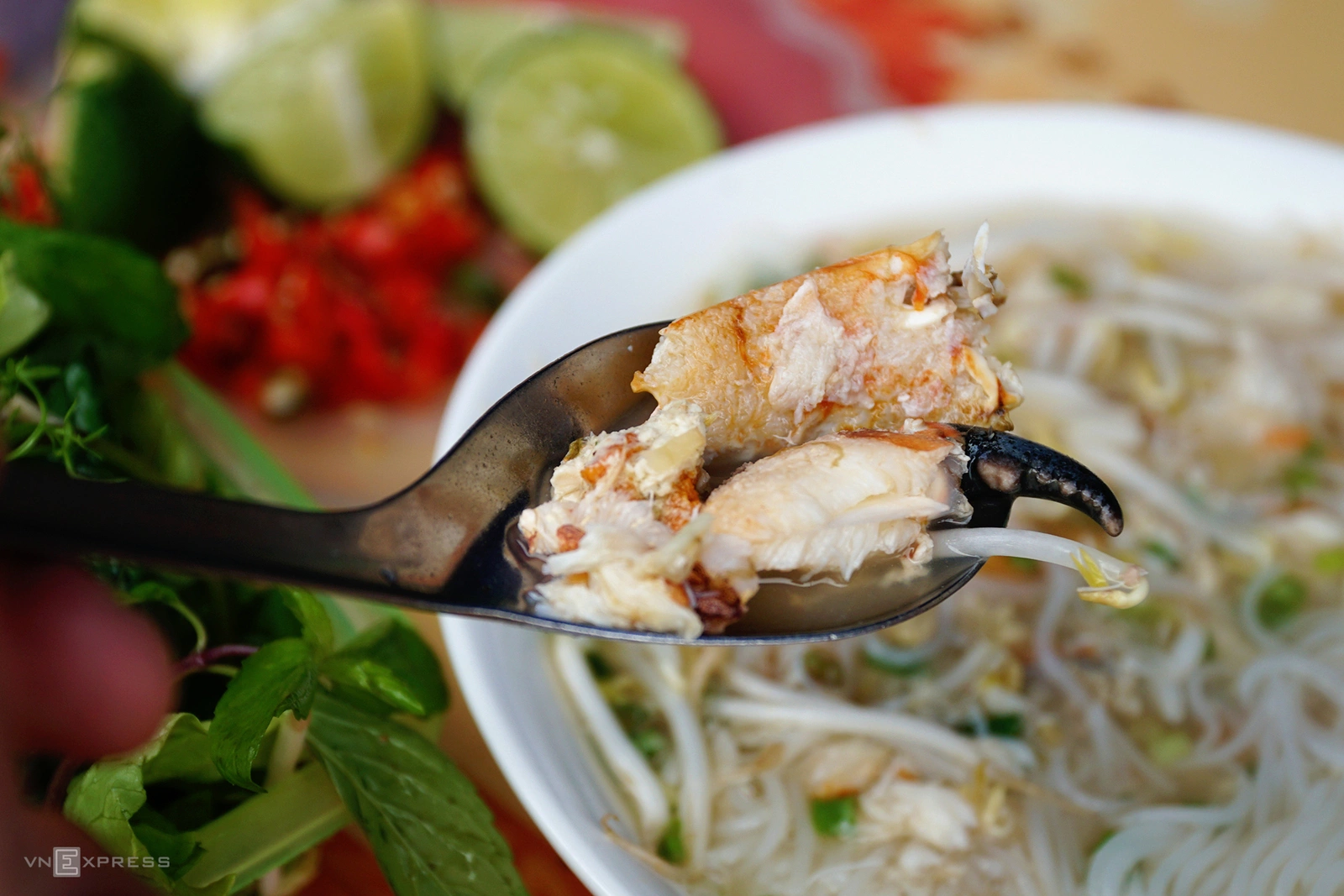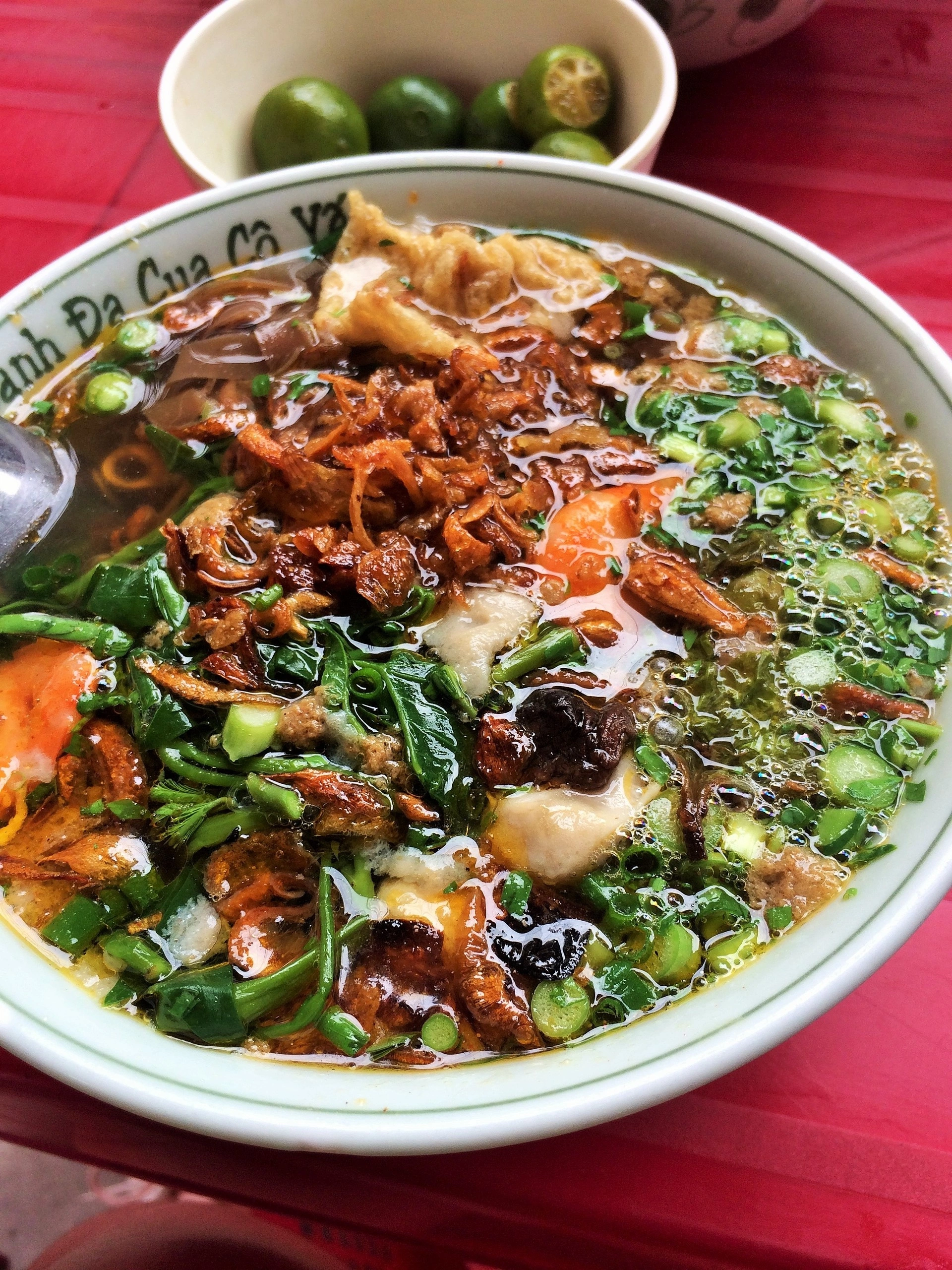HANOI

For thousands of athletes, coaches, officials in town for the SEA Games 31, Hanoi presents a great opportunity to discover delicious dishes that are particular to the capital city, like cha ca, which is fried catfish tossed with dill, onion, turmeric and galangal.
This dish has the distinction of having a street named after it in Hanoi's Old Quarter.
One of the oldest restaurants on this street, La Vong, has been serving this dish for nearly 150 years.

Diners sit at a communal table with a skillet set up over a burner. Turmeric-marinated fish is added to sizzling garlic oil, and dill and shrimp paste tossed in. The diners’ job is to add herbs, marinated hot chilies, peanuts and vermicelli, which are all laid out on the table.
A set of La Vong fried catfish costs at VND175,000 (US$7.58) per person.
Banh tom, deep fried rice powder cake with shrimp, is another Hanoi specialty that is served by a series of restaurants across the West Lake, a popular hangout area.
The most well-known restaurant for this dish is on Thanh Nien Street between the West Lake and Truc Bach Lake. It is typically served with lettuce leaves for wrapping, plus chili, lime juice and fish sauce for dipping. What made the dish special in yesteryears was that it was made with freshwater shrimp caught in the West Lake.
A serving of banh tom costs from VND25,000-55,000 ($1-.0-2.38).

Pho, Vietnam's iconic noodle soup, which was named by CNN as one of the world's 20 best, is a must try dish in the capital city.
Pho 10 Ly Quoc Su is one of the most famous restaurants in Vietnam serving this dish. It is so popular that it is not uncommon to see people queuing outside, waiting their turn to get in during the peak tourist season.

The restaurant only serves beef pho, but the options are varied. You can have pho with cooked or poached beef flank, beef brisket or stewed beef in Bordelaise sauce. A bowl of the fragrant, tasty soup costs VND55,000 – 80,000.
Bun cha, a bowl of savory, sweet and sour fish sauce with meatballs and thick pork slices served with a plate of white vermicelli, has had its profile boosted after former President Barack Obama enjoyed this dish during his 2016 trip to Vietnam.
Bun cha is typically served with seafood spring rolls, crab spring rolls and grilled skewers.

Some famous addresses to try the dish are 74 Hang Quat Street and Huong Lien Stall on Le Van Huu Street where Obama and the late chef Anthony Bourdain visited in 2016.
Yet another local favorite is pork rib congee, particularly on cold days. A bowl of rib congee costs VND25,000-30,000.
Many Hanoians say that a nameless roadside stall at 2A Ly Quoc Su Street serves the best rib porridge in the city. This hot treat can also be found in the famous Dong Xuan Market.

No trip to Hanoi can be complete without visiting some of its coffee shops. Some of the more prominent outlets are 91 Nguyen Huu Huan Street in Hoan Kiem District, Yen Cafe at 184 Quan Thanh Street in Ba Dinh District, and All Day Coffee at 37 Quang Trung Street in Hoan Kiem District for egg coffee, an undoubted Hanoi specialty.
HA LONG

The Ha Long Bay, a UNESCO world heritage site in the northern province of Quang Ninh, is renowned for its limestone karsts, caves, floating villages and stunning beaches.
Besides its scenic beauty, the place boasts some food attractions.
Bun be be, or noodles with mantis shrimp, is a common breakfast and lunch dish in Ha Long. The dish is sold at local markets, including seafood markets near the beach and the Bai Chay tourism complex. A bowl of mantis shrimp noodles costs VND30,000-40,000.

Another Ha Long specialty to try is a noodle soup with cu ky, or thunder crab, because most of the edible thunder crabs are found here. This crab has a small body with a lot of crust and little flesh, so people mainly use pincers filled with flesh to make the dish.
The broth of the noodle is also cooked with the crab. Cooks at some restaurants also add shrimp or mantis shrimp to a bowl so that the dish looks more appetizing.

The dish is served at local markets at the Bai Chay beach or Gieng Don area. Each serving costs VND35,000-50,000.
Squid fritters (cha muc) is among the most famous dishes in Ha Long. Locals have this with steamed rice rolls (banh cuon). This is different from other localities where banh cuon is usually served with pork paste.
In Ha Long, steamed rice rolls with squid can be found at any time of the day. Some famous restaurants to try this are Ba Ngan, Ba Yen and Goc Bang. A serving costs VND30,000 - 55,000 depending on how much squid you order.

A must-try dessert in Ha Long is yoghurt with tapioca balls, or boba. The bobas are dipped in sweetened coconut milk and served with yoghurt, all ingredients homemade.

Try this dessert at Lien Tuan or Co Nghi restaurant for VND10,000-30,000.
HAI PHONG

Hai Phong, around two hours east of Hanoi, is home to the UNESCO-recognized Cat Ba biosphere reserve and Lan Ha Bay. Like many places in Vietnam, it has great street food options.
One signature dish of the place is "banh da cua" which features flat, brown noodles cooked with crab meat, shrimp, pork meatballs, pork wrapped in la lot (piper lolot leaves), morning glory, green onions and other veggies.

The broth is especially nourishing with crab meat, vegetables and spices.
Try the dish at 143/46 Lach Tray, 2b Pham Ngu Lao, Ms. Thai's stall inside Chu Van An market or 16 Phan Chu Trinh.
Spicy breadsticks with a filling of "pate," or ground pork paste, and served with a special chilli sauce is served at 28 Dinh Tien Hoang, 57 Le Loi and 184 Hang Kenh.

The breadsticks are best served with the special chili sauce from Hai Phong. Photo by Ngoc Dinh
Another Hai Phong specialty is "banh duc tau," a version of jelly rice cake, served with fried shrimp, pork and papaya, all soaked in a sweet, chilly vinegary sauce. A highly popular stall serving this treat is at 159 Hai Ba Trung Street in Le Chan District.

Hai Phong is also famous for dua dam, or coconut sweet soup, and coconut milk coffee, which can be tried at 124 Lach Tray or 100/124 Lach Tray.
NAM DINH

Located around 100 kilometers to the south of Hanoi, Nam Dinh Province, once the heartland of Catholicism and still home to one of the largest populations of Catholics in the country today, also boasts several flavor-packed delicacies
Mai’s stall on a sidewalk off Phan Dinh Phung Street is a good place to enjoy banh mi with a filling of paté, fried shallots, pickled cucumber, and a bit of liquid fat for just VND8,000.

In Nam Dinh, one dish that cannot be skipped is xiu bao, its renowned version of the fried dumpling whose fillings consist of boiled quail egg, minced pork, Jew’s ear, spices, honey and pork fat.
The most famous address selling this treat is Ba Dinh store on Hoang Van Thu Street, one of the oldest xiu bao sellers, for only VND5,000 each.
Bun sung, which is actually crab noodles soup, is perfect for lunch or even an after-lunch meal. Crab noodles are popular all over the country, but Nam Dinh is perhaps the only place that adds pickled fig as an important element that supersedes the crab.
One place to try this dish is at the Dien Hong Market on Quang Trung Street. A bowl costs VND5,000-15,000.

Nam Dinh’s Kenh (Canal) Village, so called because it was an area with many canals, is well known for its banh cuon, steamed rice rolls that are served with fish sauce with high protein content that has been diluted with water, white vinegar and sugar, and some pieces of sausages.

NINH BINH
Ninh Binh, around 60 kilometers from Hanoi, achieved tourism stardom after the Hollywood blockbuster, "Kong: Skull Island," was filmed there in 2016.

The specialty to try here is goat meat.
Goat meat restaurants in Ninh Binh serve diners up to 20 dishes ranging from barbecue and spring rolls to herbal soup and curry.
While goat meat can be found everywhere in the country, the ones in Ninh Binh are said to be special with the firmest meat because they graze naturally on local limestone mountains.
Delectable goat meat dishes are served at Hoang Giang Restaurant, Hang Ca Mountain in Truong Yen District; and Hoang Long Restaurant on Trang An Street or at 446 Nguyen Hue Street.
Nem chua (fermented pork roll), made with sour pork, chilli and peppercorn is a Nam Dinh specialty enjoyed with guava leaves, some pungent herbs, fig leaves, paederia lanuginose (stinkvine or Chinese fever vine), polyscias fruticosa (ming aralia) and fish sauce.

You can try this dish at the Tuan Binh Restaurant in Hamlet 4, Yen Mac Commune.
Other dishes that carry unique flavors of the northern delta, like sour soup with fish, cellophane noodles served with eel or field crab roasted in betel leaf are other culinary offerings in Ninh Binh.
Rice crackers are also a signature specialty that has contributed to popularizing Ninh Binh on the global cuisine map.
PHU THO

Around 90 kilometers from Hanoi, Phu Tho Province holds a singular place in the nation’s history as home to the temple on Nghia Linh Mountain in Viet Tri Town where the Hung Kings, Vietnam’s founders, are worshipped.
Every year, on the 10th day of the third lunar month, tens of thousands of visitors from across the country flock to the temple and offer incense to the nation’s founders on their death anniversary and the town lights up with impressive firework displays and art performances.
From a culinary standpoint, a must-try Phu Tho specialty would be the banh tai (ear cake), a rice cake with a pork filling. The cake is molded in shape of an ear and uses fish sauce as its dip. As a local specialty, it's not difficult to find the dish at street-side stalls and restaurants.
Thanh Son sour pork, a speciality of the Muong, is made from badger pig husbanded by the ethnic minority community. The pig is only fed vegetables and wild fruits. The dish is usually served with guava, clove and fig leaves with a spicy chili sauce.
Apart from these two specialties, the food street on Nguyen Du Street in Nong Trang Ward hosts more than 100 food and beverage businesses serving all kinds of Phu Tho specialties including BBQ, rolls and vermicelli dishes.
Story by Nguyen Quy